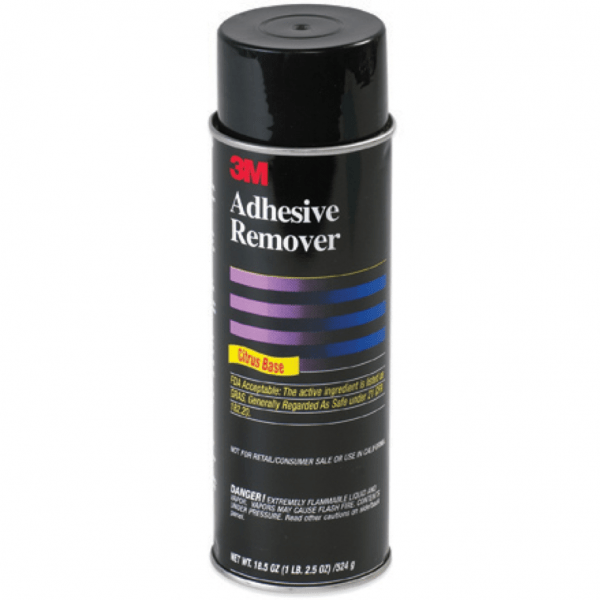We use tape for a variety of reasons. Sometimes it’s just temporary but most of the time we want the tape to stick and stay put. What happens if we need to remove adhesive tape? How can we accomplish that without damaging the surfaces? What do we do about removing the tape residue?
This short post will give you some suggestions on ways to remove adhesive tape and any sticky residue using common household items.
How to Remove Adhesive Tape
When it comes to the best ways to remove adhesive tape, let’s start with a simple example. Suppose you need to remove some duct tape from a plastic or a piece of metal. Take a utility knife or putty knife and get the leading edge started by lifting at the corner. Once you get the tape lifted, you can reach under with your fingernail and start to pull it back. Depending on the tape’s structure and the adhesive system, this could be a fairly easy or extremely difficult way to remove adhesive tape.
Peel the tape back at an angle between 90 and 180 degrees. In some cases, pulling slowly will yield better results and sometimes a quicker pull might work much better. There’s no perfect answer. Once the tape is removed, there’s a good possibility that you will have some adhesive residue left behind.
One quick trick is to take a piece of the same duct tape if you have it and quickly apply the tape over the residue and quickly pull it away. Many times, the new piece of tape will help to remove the residue or at least some of it.
For the remaining residue, your next stop is your medicine cabinet. Isopropyl alcohol (also called rubbing alcohol) is one of the safer, readily available solvents most people have on hand. IPA as it’s often called won’t harm plastic surfaces or the paints on metal surfaces. Apply a small amount of IPA to a paper towel if it’s a vertical surface and then begin wiping. The IPA is not a true solvent for the adhesive (it doesn’t dissolve it) but it will help to loosen the residue and with a little “elbow grease” it will work on many surfaces.
If it’s a horizontal surface, you can pour a small amount on the residue and let it sit for a minute and then start scrubbing with an IPA soaked paper towel.
Nail polish remover (mostly acetone) can be useful on bare metal surfaces such as aluminum or stainless steel but will mar many plastics and should be used cautiously.
Warm soapy water or hot water will work on many common labels since the adhesive is often a water-based system and the soap and water will help loosen the bond. Most duct tapes and higher performance tapes however are made with adhesives that are water resistant so the soap and water approach won’t work very well.
Another possibility is baby oil. Applying a small amount to the residue can sometimes swell the adhesive slightly and help to loosen the bond. The residue can sometimes be lightly scraped away if there’s no concern about scratching the surface or IPA can then be used as a follow up wipe to remove the oil and the swelled residue.
Commercial Solvents
If you need to bring out the “big guns” to remove adhesive tape, there are much stronger solvents that can be purchased at many local hardware stores. These solvents will work on adhesive residue but caution is required and some of these can be a little on the expensive side.

Mineral spirits is relatively safe and will work on metals and many plastics but it’s best to test a small area first to make sure. Heptane is also readily available and will also work well but again, a small test should be done to make sure you don’t ruin any painted surface or mar any plastic.
Some hardware stores carry methyl ethyl ketone also called MEK. This is one of the best clean up solvents for adhesives and many tape manufacturers use it to clean their coating equipment but it is very aggressive and cannot be used on plastics or many painted metals. You can use it on bare metals and glass so be very careful with this solvent!
One of the safer “industrial strength” adhesive removers is made by 3M (pictured on to the left). It’s a citrus based remover and works very well on painted metals and plastics. It’s in an aerosol can so it’s easy to apply and has a pleasant citrus odor.
You can order it on Amazon. It’s safe and works very well.
Contact Tom Brown, Inc. for More Information
If you have any further questions, feel free to contact us and we’ll be happy to assist you!
Contact Tom Brown, Inc. with any questions.
 Mineral spirits is relatively safe and will work on metals and many plastics but it’s best to test a small area first to make sure. Heptane is also readily available and will also work well but again, a small test should be done to make sure you don’t ruin any painted surface or mar any plastic.
Some hardware stores carry methyl ethyl ketone also called MEK. This is one of the best clean up solvents for adhesives and many tape manufacturers use it to clean their coating equipment but it is very aggressive and cannot be used on plastics or many painted metals. You can use it on bare metals and glass so be very careful with this solvent!
One of the safer “industrial strength” adhesive removers is made by 3M (pictured on to the left). It’s a citrus based remover and works very well on painted metals and plastics. It’s in an aerosol can so it’s easy to apply and has a pleasant citrus odor. You can order it on Amazon. It’s safe and works very well.
Mineral spirits is relatively safe and will work on metals and many plastics but it’s best to test a small area first to make sure. Heptane is also readily available and will also work well but again, a small test should be done to make sure you don’t ruin any painted surface or mar any plastic.
Some hardware stores carry methyl ethyl ketone also called MEK. This is one of the best clean up solvents for adhesives and many tape manufacturers use it to clean their coating equipment but it is very aggressive and cannot be used on plastics or many painted metals. You can use it on bare metals and glass so be very careful with this solvent!
One of the safer “industrial strength” adhesive removers is made by 3M (pictured on to the left). It’s a citrus based remover and works very well on painted metals and plastics. It’s in an aerosol can so it’s easy to apply and has a pleasant citrus odor. You can order it on Amazon. It’s safe and works very well.

